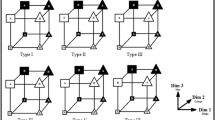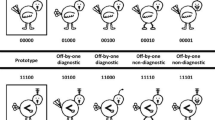Abstract
We present a general neural model for supervised learning of pattern categories which can resolve pattern classes separated by nonlinear, essentially arbitrary boundaries. The concept of a pattern class develops from storing in memory a limited number of class elements (prototypes). Associated with each prototype is a modifiable scalar weighting factor (λ) which effectively defines the threshold for categorization of an input with the class of the given prototype. Learning involves (1) commitment of prototypes to memory and (2) adjustment of the various λ factors to eliminate classification errors. In tests, the model ably defined classification boundaries that largely separated complicated pattern regions. We discuss the role which divisive inhibition might play in a possible implementation of the model by a network of neurons.
Similar content being viewed by others
References
Amari, S.I.: Neural theory of association and concept-formation. Biol. Cybern. 26, 175–185 (1977)
Anderson, J.A.: Two models for memory organization using interacting traces. Math. Biosci. 8, 137–160 (1970)
Anderson, J.A.: A simple neural network generating an interactive memory. Math. Biosci. 14, 197–220 (1972)
Anderson, J.A., Cooper, L.N.: Les modeles mathematiques de l'organization biologique de la memoire. Pluriscience 168–175, Encyclopaedia Universalis, Paris (1978)
Barto, A.G., Sutton, R.S., Brouwer, P.S.: Associative search network: a reinforcement learning associative memory. Biol. Cybern. 40, 201–211 (1981)
Blomfield, S.: Arithmetical operations performed by nerve cells. Brain Res. 69, 115–124 (1974)
Bobrowski, L.: Rules for forming receptive fields of formal neurons during unsupervised learning processes. Biol. Cybern. 43, 23–28 (1982)
Brooks, L.: Non-analytical concept formation and memory for instances. In: Cognition and categorization, pp. 169–211, Rosch, E., Lloyd, B. (eds.). Hillsdale, N.J.: Lawrence Erlbaum Associates 1978
Cooper, L.N.: A possible organization of animal memory and learning. In: Proceedings of the nobel Symposium on collective properties of physical systems, Vol. 24, pp. 252–264, Lundquist, B., Lundquist, S. (eds.). London, New York: Academic Press 1973
Cooper, L.N., Liberman, F., Oja, E.: A theory for the acquisition and loss of neuron specificity in visual cortex. Biol. Cybern. 33, 9–28 (1979)
Cover, T.M., Hart, P.E.: Nearest neighbor pattern classification. IEEE Trans. Inform. Theor. 13, 21–27 (1967)
Davis, T.L., Sterling, P.: Microcircuitry of cat visual cortex: classification of neurons in layer IV of area 17, and identification of the patterns of lateral geniculate input. J. Comp. Neur. 188, 599–628 (1979)
Dean, A.F., Hess, R.F., Tolhurst, D.J.: Divisive inhibition involved in directional selectivity. J. Physiol. 308, 84p-85p (1980)
Duda, R.O., Hart, P.E.: Pattern classification and scene analysis. New York: Wiley 1973
Franks, J.J., Bransford, J.D.: Abstraction of visual patterns. J. Exp. Psychol. 90, 65–74 (1971)
Grossberg, S.: Adaptive pattern classification and universal recoding. II. Feedback, expectation, olfaction, illusions. Biol. Cybern. 23, 187–202 (1976)
Kogh, C., Poggio, T., Torre, V.: Retino-ganglion cells: a functional interpretation of dendritic morphology. Philos. Trans. R. Soc. (to be published)
Kohonen, T.: Correlation matrix memories. IEEE Trans. Comput. 21, 353–359 (1972)
Kohonen, T.: Associative memory—a system-theoretical approach. Berlin, Heidelberg, New York: Springer 1977
Medin, D.L., Schaffer, M.M.: Context theory of classification learning. Psychol. Rev. 85, 207–238 (1978)
Nass, M.M., Cooper, L.N.: A theory for the development of feature detecting cells in visual cortex. Biol. Cybern. 19, 1–18 (1975)
Poggio, T.: A theory of synaptic interactions. In: Theoretical approaches in neurobiology, pp. 28–38, Reichardt, W., Poggio, T. (eds.). London: MIT Press 1981
Posner, M.I., Keele, S.W.: On the genesis of abstract ideas. J. Exp. Psychol. 77, 353–363 (1968)
Posner, M.I., Keele, S.W.: Retention of abstract ideas. J. Exp. Psychol. 83, 304–308 (1970)
Reilly, D.L., Cooper, L.N., Elbaum, C.: An application of two learning systems to pattern recognition: handwritten characters (to be published)
Rose, D.: On the arithmetical operation performed by inhibitory synapses onto the neuronal soma. Exp. Brain Res. 28, 221–223 (1977)
White, E.L., Rock, M.P.: Three-dimensional aspects and synaptic relationships of a Golgi-impregnated spiny stellate cell reconstructed from serial thin sections. J. Neurocytol. 9, 615–636 (1980)
Author information
Authors and Affiliations
Additional information
This work was supported in part by the Alfred P. Sloan Foundation and the Ittleson Foundation, Inc.
Rights and permissions
About this article
Cite this article
Reilly, D.L., Cooper, L.N. & Elbaum, C. A neural model for category learning. Biol. Cybern. 45, 35–41 (1982). https://doi.org/10.1007/BF00387211
Received:
Issue Date:
DOI: https://doi.org/10.1007/BF00387211




